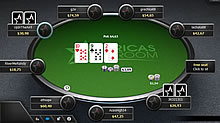For everyone who wants to know exactly how to calculate poker odds for hitting a card on turn or river can read below how it works. Learning how to calculate the odds and outs is an important factor in Texas Holdem. You will be able to calculate the chances of hitting your flush or straight on the turn or river or what the chances are of getting an overcard on the flop. You will also learn to calculate the number of times you’re going to flop a set with your pocket pair. These calculations are very important factors to know in poker and knowing these statistics is essential for becoming a winning player.
Next, a short explanation of some terms you will read in this article.
Outs: The number of cards left in the deck that will improve your hand.
Pot odds: The odds you are getting when comparing the current size of the pot versus your next call.
Implied odds: The odds you get after the assumed result of betting for the next rounds of betting.
If you reach the flop with a number of outs, you’ll have to calculate your chances of hitting one of those outs on turn or river.
Suppose you hold


and the flop comes



You have a flushdraw and it gives you nine outs for hitting a flush on turn and river. If you want to know the chances of a club on the turn you divide the number of outs by the 47 unseen cards and multiply it with 100%.
For our flushdraw we have a chance of 9/47 * 100% = 20% of catching a club on the turn. To calculate the probability of catching a club on turn and river together you’ll have to calculate the chance that none of your outs will apear on turn or river.
With nine outs on the flop you have a 38/47 * 37/46 * 100% = 65% chance of not catching one of your nine outs. This means you have a chance of 1 – 65% = 35% you do hit one of your outs on turn or river.




